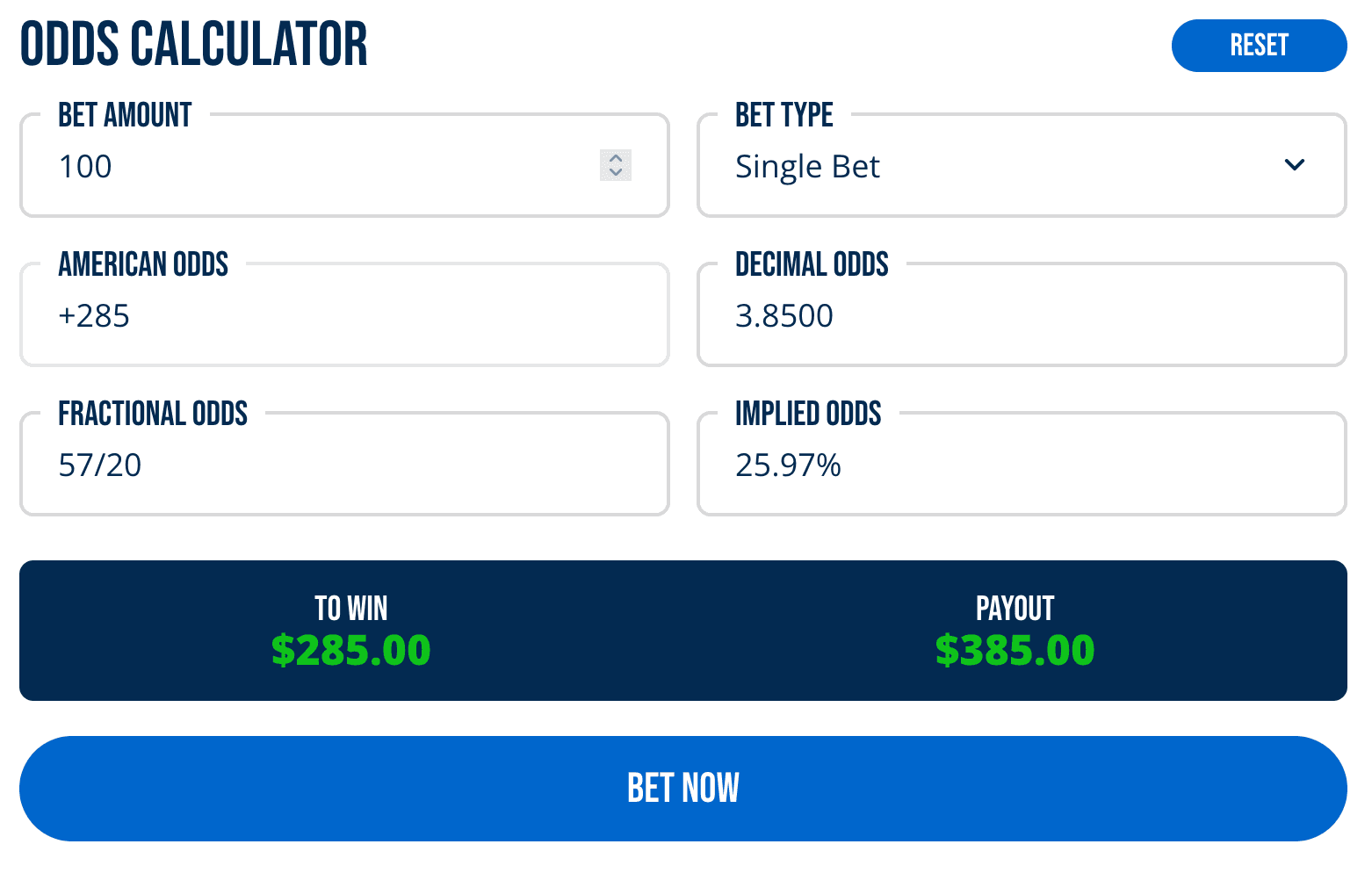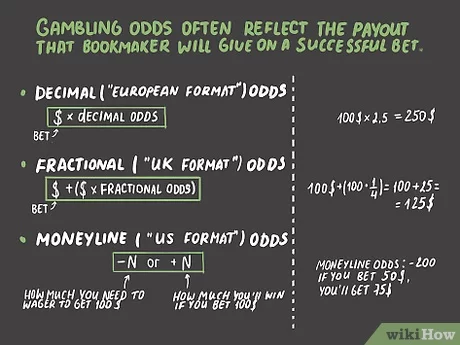How are sports betting odds calculated

Implied probability is the expected chance of an outcome as determined by bookmakers, and it's shown using odds. For serious bettors who want to. In other words, 6/1 is the ratio of the potential profit to the initial bet. Therefore, if you stake $10 at 6/1 and win, you'll get how are sports betting odds calculated total payout of $70 ($ Can you calculate probability from odds? · Negative odds (use positive numbers in the calculation): Odds/(Odds+)* = implied probability. Odds of ; If you want to bet on Golovkin to win the fight (8/13 odds), calculate your winnings by multiplying your wager by the quotient of 8 ÷ 13 (). If you bet $
The Intricacies of Calculating Sports Betting Odds
When delving into the world of sports betting, one must comprehend the complex calculations behind the odds that drive both bookmakers and bettors to make crucial decisions.
Understanding the primary factors: Multiple elements contribute to the formulation of betting odds. These include historical data, team or player performance, injuries, weather conditions, and other relevant variables that impact the outcome of a sports event.
The role of probability: Odds are essentially a reflection of the probability of a specific outcome occurring, with lower odds indicating a higher probability and vice versa. Bookmakers employ advanced statistical models to predict these probabilities with precision.
Key components in odds calculations: The primary components involve the implied probability, the bookmaker's margin, and the odds format used. Implied probability represents the conversion of odds into a percentage, while the bookmaker's margin ensures a profit margin for the operator.
Methods of odds representation: Odds can be presented in different formats, including decimal, fractional, and American. Each format conveys the same information but in different ways, catering to diverse preferences among bettors.
Calculating Odds: A Simplified Example
Consider a football match between Team A and Team B. If the bookmaker assesses that Team A has a 60% chance of winning, the corresponding decimal odds would be 1.67 (1 divided by 0.6). This implies that for every $1 wagered on Team A, the bettor would receive $1.67 in return if the team emerges victorious.
Conversely, if the bookmaker estimates Team B's chances at 25%, the decimal odds for Team B would be 4.00 (1 divided by 0.25). This signifies that a $1 bet on Team B would yield $4 in profit upon winning.
Conclusion: Sports betting odds are intricately calculated, blending data analysis, probability assessments, and margins for bookmakers. Understanding these calculations offers insight into the betting landscape and aids in making informed wagering decisions.
Understanding sports betting odds and calculating value bets
Sports Betting Odds: How They Work and How to Read
Furthermore, the odds on display never reflect the true probability of an event occurring or not occurring. The payoff on a win is always less than what one should have received if the odds had reflected the true chances. If you or someone you know has a gambling problem, call the National Problem Gambling Helpline at , or visit ncpgambling. American Gaming Association.
Science Daily. Journal of Gambling Studies. Wizard of Odds. American Psychiatric Association. Table of Contents Expand. Table of Contents. Converting Different Types of Odds. Converting Odds into Probabilities. Psychological Considerations. The Bottom Line. Trading Skills Trading Psychology. Trending Videos. How are sports betting odds calculated Key Takeaways The three types of odds are fractional, decimal, and moneyline also known as "American" odds.
One type of odds can be converted into another, and may also be expressed as an implied probability percentage. A key to assessing an interesting opportunity is determining if a probability is actually higher than the implied probability reflected in the odds. Technically, the house always wins because the bookmaker's profit margin is also factored into the odds.
Article Sources. Investopedia requires writers to use primary sources to support their work. These include white papers, government data, original reporting, and interviews with industry experts. We also reference original research from other reputable publishers where appropriate.
You can learn more about the standards we follow in producing accurate, unbiased content in our editorial policy. Compare Accounts. The offers that appear in this table are from partnerships from which Investopedia receives compensation. This compensation may impact how and where listings appear. Investopedia does not include all offers available in the marketplace.
Take the Next Step to Invest.  American odds are the most common in the U. Before the surge of online sportsbooks, a few powerful Las Vegas casinos were the standard for setting the odds. Vegas odds and sportsbooks are still often used by established sports bettors because the wager limits are usually the highest and encourages more money to be put down.
American odds are the most common in the U. Before the surge of online sportsbooks, a few powerful Las Vegas casinos were the standard for setting the odds. Vegas odds and sportsbooks are still often used by established sports bettors because the wager limits are usually the highest and encourages more money to be put down.
Information on each type of odds is critical for bettors to know in order to place a wager and calculate potential winnings at the best sports betting sites. American odds are most commonly found on both online and land-based sportsbooks. Favorites, a bet that has a higher probability to win, will always have a minus next to its odds while underdogs, a bet that is most likely to lose, always have a plus.
Fractional odds are more popular in the U. Unlike American odds, understanding plus and minus signs is unnecessary with fractional odds. They can also be easily converted into other types of odds including American and decimal. Calculating fractional odds is fairly straightforward.
It is determined by multiplying the amount wagered by the fraction. Unlike fractional odds and American odds, decimal odds factor in the initial stake. Understanding how decimal odds work is fairly less complicated than American and fractional odds. Moneyline odds are a variation of American odds, but this type of bet only awards profit to bets on a winning team, regardless of the final margin.
Bettors must also have a comprehensive understanding of how to read betting odds before placing any wagers. To determine how much to risk to profit a certain amount with negative odds, the simplest way is converting odds to decimals. Implied probability is evaluated based on the odds of the event occurring.
The higher the percentage, the more likely the event is to occur. With American and moneyline odds, the implied probability equation is different for both favorites and underdogs negative and positive numbers. That equals 0. Wagering on odds would require the bettor to win at least 90 percent of the time to make a long-term profit. The quotient would result in.
In addition, we will explore the benefit of having a Skrill account in the world of sports betting. In the context of sports betting, a market is a specific type of bet you can place on a sporting event, for example the outcome of a football match or the number of sets in a tennis match.
For each market, there is a betting odd. Betting odds are numbers that indicate how much you stand to win if you place a bet and the event occurs. In this way, they also reflect the probability that the bookmaker assigns to the event e. The higher the odds, the less likely the event will happen.
A value bet occurs when a punter believes that the odds of an event occurring are greater than the odds assigned by the bookmaker, thus presenting potential opportunities. As odds are an indication of the likelihood of an event or outcome occurring, they are influenced by three factors:. Betting odds can be presented in different formats, such as decimal odds, fractional odds or money line odds, depending on the region or bookmaker.
Decimal odds represent the total amount you will be paid if the bet wins, including the original stake. Fractional odds represent the potential profit in relation to the bet. Fractional odds are shown as a fraction, i. Money Line odds, or American odds, have their own way of representing probability.
Popular Pages
- What does double your winnings in sport bet mean
- When was sports betting legalized in nj
- How to turn over money on sports bet
- Who is the girl in the sports bet ad
- Do i have to report sports betting on taxes
- What app is better tab app or.sports bet
- Does wisconsin allow sports betting
- What is a multiple sports bet
- What sports betting app is legal in florida
- What is the easiest sport to bet on